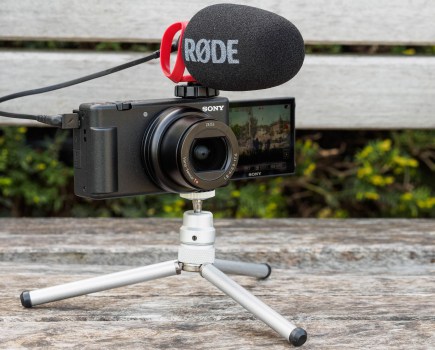The all-new Canon EOS C100 Mark II is a fantastic addition to the Canon Cine lineup, but how much of an improvement does it represent over the original model? We spoke to Guy Thatcher from www.hireacamera.com who talked us through the features of the new camera
Watch the video to hear Guy’s full expert opinion on the Canon EOS C100 and C100 Mk II
You could be forgiven for taking a first glance at the C100 Mark II and concluding that it doesn’t look all that different from the Mark I.
It’s not until you get in for a closer inspection that you start to appreciate that there really are some notable feature improvements, as Hire A Camera’s Guy Thatcher observes in our interview.
For starters there’s the improved 3.5-inch OLED display. It’s now hinged on the left side of the camera body, making it much more flexible than the awkward top hinge on the C100. On the Mark II it’s also now possible to flip and rotate the screen up to 270°, helping you shoot at extreme angles or even to allow the people on-camera to view themselves during filming.
The electronic viewfinder has also received a sensible and much-appreciated rethink. On the original version, the viewfinder was small and fixed, and to be frank this made it of limited use in many shooting situations. The C100 Mark II’s viewfinder can be pulled out and tilted upwards in a manner similar to the one Canon stuck on the higher-end EOS C300, making it both more user-friendly and more practical.
Recording audio has been made easier with the newer C100, now that internal audio recording is available. There are XLR inputs for external recording too of course, but if you don’t have external audio recording equipment, you can use to the camera’s internal stereo microphone.
There’s also the option to control the audio gain manually using the dials on the camera’s handle, giving users greater control over their sound.

The C100 Mark II answers some criticisms videographers had of the original C100
Internals
Where there’s no change is in the sensor – the Mark II sports the same unit as its predecessor. Guy argues that this is no bad thing, given how good the footage from the original C100 was. However it’s stil something to bear in mind when deciding whether you want to upgrade.
With that said, the C100 Mark II does bring to the party an updated Digic 4 Processor, which sees the ISO sensitivity range expanded to ISO 320-102,400. This gives the Mark II the crucial advantage of being significantly more capable than its predecessor in low-light conditions.
Now capable of recording using the AVCHD II codec, the newer C100 can capture 1080p footage at 60-frames-per-second (28MBps). We’d ideally have liked a higher frame rate, but it’s better than what we had previously, so it’s good to see. The dual pixel AF system that proved popular in the C300 and 7D Mark II has also made its way into the C100 Mark II, delivering mostly reliable face-detection AF and tracking that’s a great help in run-and-gun situations.
Speaking of dual capabilities, the C100 Mark II can record different formats of footage simultaneously, making it possible to capture standard and high definition footage at the same time, or record movies with two different frame rates. Putting it plainly, this means it’s possible to record slo-mo and standard motion footage at the same time, in camera, which we think you’ll agree is pretty cool. Lastly, the addition of Wi-Fi adds a simplified method of controlling the camera remotely.
Overall, the Canon EOS C100 Mark II is a brilliant camera. Is it a huge leap beyond the previous model? Well, the original C100 was, and still is, a superb camera. But the new model delivers some significant refinements that solve some niggles that people may have had with the older version.






